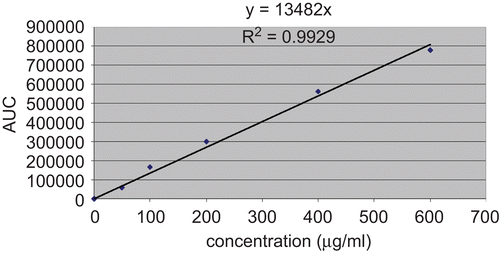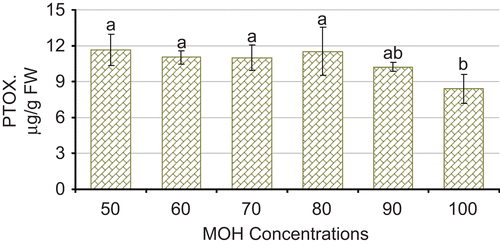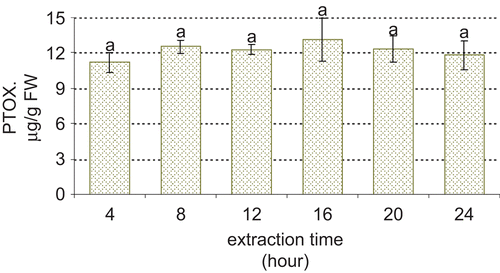Abstract
Context: Suspension cultures of Linum album Kotschy ex Boiss. (Linaceae) accumulate podophyllotoxin (an anticancer agent) and could therefore serve as an alternative source of this important aryltetralin lactone lignan.
Objective: The present work compared four podophyllotoxin extraction methods and optimization of the best one by using single factor experiments.
Materials and methods: Linum album cell cultures were established from in vitro plantlets and subcultured in MS medium with hormones every 7–8 days. Four podophyllotoxin extraction methods were assayed and the best one was optimized by single factor experiments, studying the effect of methanol concentration, extraction time, and sonication time.
Results: Cell cultures accumulated enough podophyllotoxin to be analyzed by HPLC. The methanol/dichloromethane and buffer extraction methods were found to be the best. Methanol alone and hot ethanol were not effective for extracting podophyllotoxin.
Discussion and conclusion: The optimized method based on methanol/dichloromethane extraction combined with HPLC quantification was able to determine small amounts of podophyllotoxin in Linum album cell cultures, showing that this system could constitute a possible alternative source of podophyllotoxin to Podophyllum (Berberidaceae).
Introduction
Podophyllotoxin (PTOX) is a natural lignan () used in important anticancer drugs including etoposide, teniposide and Etopophos as well as a new drug, CPH 82, for rheumatoid arthritis (CitationKartal et al., 2004).
Podophyllotoxin has been shown to have antiviral activity, inhibiting the replication of measles and the herpes simplex type I virus. It has also been used to treat the human papilloma virus (HPV). PTOX can be used against Molluscum contagiosum, a skin disease associated with children, young adults and HIV patients. PTOX also possesses an outstanding antitumor property that is effective against lung cancer, different types of genital tumors, and lymphomas (CitationIzadifar & Baik, 2008).
Traditionally, PTOX has been extracted from two major sources, Podophyllum emodi Wall. and Podophyllum peltatum L. (Berberidaceae), both of which have become endangered species as a result of over-collection. Besides the Berberidaceae members, PTOX is also found in other plant genera such as Linum, Juniperus, and Callitris (CitationFuss, 2003; CitationFarkya et al., 2004; CitationPandey et al., 2007).
The genus Linum consists of about 230 species, mainly annual or perennial herbs as well some small shrubs, which are distributed all over the world in different habitats (CitationKartal et al., 2004). In the flora of Iran, Linum is represented by 15 species, three of which are endemic (CitationSharifinia & Assadi, 2001).
Recently, tissue cultures of the endemic Iranian flax (Linum album Kotschy ex Boiss.), become an attractive alternative source of podophyllotoxin.
Since the chemical synthesis of PTOX is very expensive (CitationIzadifar & Baik, 2008), the extraction of this compound from natural sources has attracted the attention of pharmaceutical industries.
CitationKartal et al. (2004) compared three extraction methods: aqueous, glucosidase and acetone, for PTOX and its derivatives in Linum species, but no significant differences were perceived. Since the enzymatic method needs the expensive β-glucosidase and was not observed to be better than the others, we did not include it in our study.
The main objectives of this research were aimed 1) to compare four PTOX extraction methods and optimize the best one by studying the effect of methanol concentration, extraction time and sonication time by single factor experiments, and 2) to evaluate the content of PTOX in Linum album cell cultures with respect to a possible use as an alternative source instead of Podophyllum.
Materials and methods
Chemicals
Analytical grade acetone, ethyl acetate, methanol, KH2PO4, K2HPO4, high performance liquid chromatography (HPLC)-grade acetonitrile (Merck, Germany), podophyllotoxin (P-4405, Sigma, St Louis, MO) and chromatographic grade double distilled water were used.
Plant material
Linum album seeds were collected in July 2008 from Sohanak, Tehran, Iran, at an altitude of 1900 m. The plant material was identified by Dr. Shahrokh Kazempour and a voucher specimen was deposited at the Herbarium, Biological Sciences Faculty, Tarbiat Modares University, Tehran, Iran.
In vitro cultures
To establish cell suspensions of Linum album, we followed the method described by CitationSmonlly et al. (1998) with some modifications. Sterile seeds were treated with gibberellic acid (GA3) (500 mg/L) in a sterile agar medium (0.9%). Callus cultures were initiated from seedlings (upper parts) on Murashige and Skoog (MS) basal medium supplemented with sucrose (3%), naphtalene acetic acid (NAA) (2 mg/L) and kinetin (0.4 mg/L) and were solidified with agar (0.6%) at pH 5.6 before autoclaving. Callus cultures were subcultivated every 4 weeks. Suspension cultures were initiated by transfer of callus tissues into liquid MS medium (similar amount as above, but without agar; 30 mL in 100-mL Erlenmeyer flasks) and were incubated on a rotary shaker (120 rpm). Cells (5 g) were subcultured in the same medium every 7–8 days. The cultures were maintained at 25° ± 2°C under permanent darkness. The cells were separated from the medium by filtration under suction, weighed immediately and frozen immediately in liquid nitrogen before being transferred to a freezer. Afterwards, the frozen cells were powdered.
Extraction methods
Method 1: methanol extraction
For the extraction of PTOX, 2 g of powdered cell was sonicated with methanol (pure) for 15 min at 4°–6°C. Cells were then allowed to extract at 4°–6°C for 24 h for complete extraction in methanol. The supernatant was removed after centrifugation (5000 rpm, 10 min) and evaporated to dryness. The extract was redissolved in HPLC grade methanol and then subjected to analysis by HPLC (CitationBaldi et al., 2008).
Method 2: buffer extraction
Powdered plant cells (2g) were mixed with 10 mL 25 mM potassium phosphate buffer at pH 7.0 and extracted for 1 h in a 100-mL Erlenmeyer flask by magnetic stirrer. Stirring continued for another 1 h after addition of 10 mL ethyl acetate. After centrifugation, the aqueous and organic phases were separated and the ethyl acetate layer was evaporated to dryness under reduced pressure. The residue was dissolved with methanol and then injected into the HPLC (CitationCanel et al., 2001).
Method 3: hot ethanol extraction
PTOX was extracted by heating 2 g of powdered plant cells in ethanol at 60°C for 30 min with constant stirring using a magnetic stirrer, followed by sonication for 15 min. The supernatant obtained after centrifugation at 12,000 rpm for 10 min was evaporated to dryness under vacuum. The residue was dissolved with methanol and then injected into HPLC (CitationChattopadhyay et al., 2004; CitationZhang et al., 2007).
Method 4: methanol/dichloromethane extraction
Powdered plant (2 g) was extracted by sonication in methanol (80% v/v) during 1 h. Dichloromethane (4 mL) and water (4 mL) were added to obtain a partition of compounds between two layers. The dichloromethane fractions were then collected, dried and dissolved in 1 mL of HPLC grade methanol and then injected into the HPLC (CitationVan Uden et al., 1989).
Experimental design for single factor experiments
The optimal conditions for the extraction of PTOX with the selected method (methanol/dichloromethane extraction) were investigated.
| (1) | PTOX was extracted using a complex solvent of methanol and water at room temperature for 24 h. The proportion of methanol in the solvent varied in the range of 50–100% (v/v). The best solvent concentration was selected according to the acquired ratio of PTOX. | ||||
| (2) | Using the solvent selected in the previous step, PTOX was extracted with different sonication times ranging from 15 to 90 min. | ||||
| (3) | Using the best methanol concentration and sonication time selected in the two previous steps, PTOX was extracted during different time periods, ranging from 4 to 24 h after sonication. | ||||
HPLC analysis
The presence of PTOX in the samples was verified by comparison of the Rt and UV spectral peaks of the sample with those of an authentic sample. UV spectra were measured online using a Thermo Quest. The HPLC system (Thermoquest, Egelsbach, Germany) was equipped with a Spectra System KO 6000 LP photodiode array detector. A Grom-Sil 120 ODS-3 ST, 5 μm C18 (250 mm × 4.6 mm) column. A guard column Grom-Sil (Grom, Rottenburg, Germany) 120 ODS-3 ST, 5 μm C18 (50 mm × 4.6 mm) was used to safeguard the analytical column. The detector was set at 290 nm. In the present work all injection volume was 20 μL. All the calculations for quantitative analysis were performed with linear regression external standardization by measurement of peak areas.
A gradient system with acetonitrile (A%) and water (B%) was used as follows: (0 min): A (40), B (60), flow rate (0.8). (17 min): A (67), B (33), flow rate (1). (18 min): A (40), B (60), flow rate (1). (20 min): A (40), B (60), flow rate (0.8). Five concentrations of PTOX were subjected to linear regression analysis to calculate the calibration equation. Calibration for PTOX ranged from 100 to 600 μg/mL, with a regression line equation Y = 3497.7 + 13428 X; n = 4; r = 0.9929 ().
Statistical treatment
All data were analyzed using MSTAT-C software. Duncan’s multiple range tests were used to measure statistical differences between treatment methods and controls. P ≤0.05 or ≤0.01 was considered significantly different.
Results and discussion
We compared the effectiveness of the different reported methods for the extraction of PTOX from plant material (CitationCanel et al., 2001; CitationVan Uden et al., 1989; CitationZhang et al., 2007; CitationBaldi et al., 2008; CitationChattopadhyay et al., 2004), applying them to Linum cell cultures. As can be seen in , the best results were obtained by using methanol/dichloromethane, followed by the buffer method. In the buffer method, rehydration of powdered tissues of Podophyllum peltatum L. prior to extraction with an organic solvent allows endogenous β-glucosidase to hydrolyze lignan 4-O-β-glucosides in situ and increase the yield of PTOX (CitationCanel et al., 2001). The commercial production of PTOX is based on an ethanol extraction process where warm ethanol is percolated through dried plant materials (i.e., the rhizome particles of P. peltatum) followed by purification. But this method is not suitable for the extraction of PTOX from cell cultures (). In the selected dichloromethane/methanol method the optimal methanol concentration and times of sonication and extraction were determined.
As shown in , for PTOX extraction methanol concentrations of 50–80%, are better than 90–100%. Alcohol mixed with up to 50% water gives the best blend for lignan extraction. The minimum alcohol concentration should be at least 50%, but preferably 60–80% Citation(Westcott & Muir, 1998; CitationMeagher et al., 1999; CitationZhang et al., 2007).
As shown in and , no significant differences were found when using different times of sonication and extraction, indicating that they had no effect on the acquired ratio of PTOX. The fact that the collected cells were immediately frozen in liquid nitrogen, transferred to a freezer and then powdered resulted in their complete destruction. Therefore, the cell culture was not significantly affected by the sonication and extraction times.
The in vitro production of PTOX in cell cultures of Podophyllum sp. and Linum sp. has been previously reported (CitationPetersen & Alfermann, 2001), with cell contents in the range of 0.9–2 mg/g dry weight (dw). These results are higher than the PTOX production obtained in the conditions of this work (≈0.4 mg/g dw) and show that the production of the L. album cell cultures could be improved in the future by changing some of the conditions, such as hormone concentrations or the nutritive basal medium.
Conclusions
Taken as a whole, our results show that an optimized PTOX extraction [dichloromethane/methanol (60–80%)] combined with determination by HPLC is an accurate method for the quantification of small amounts of PTOX in plant material such as L. album cell cultures. Additionally, the PTOX production achieved in this work and recovered by the optimized extraction method (<0.37 mg/g dw) suggests that L. album cell cultures constitute a promising biotechnological system for producing this anti-cancer agent. When comparing our PTOX production with others previously reported (CitationSmonlly et al., 1998; CitationSeidel et al., 2002), we can infer that our system should be optimized to be competitive at an industrial level.
Declaration of interest
This research was financially supported by Tarbiat Modares University, Tehran, Iran.
References
- Baldi A, Srivastava AK, Bisaria VS. (2008). Improved podophyllotoxin production by transformed cultures of Linum album. Biotechnol J, 3, 1256–1263.
- Canel C, Dayan FE, Canzera M, Khan IA, Rimando A, Burandt CL, Moraes RM. (2001). High yield of podophyllotoxin from leaves of Podophyllum peltatum by in situ conversion of podophyllotoxin 4-O-β-glucopyranoside. Planta Med, 67, 97–99.
- Farkya S, Bisaria VS, Srivastava AK. (2004). Biotechnological aspects of the production of the anticancer drug podophyllotoxin. Appl Microbiol Biotechnol 65: 504–519.
- Fuss E (2003): Lignans in plant cell and organ cultures: An overview. Phytochem Rev, 2, 307–320.
- Chattopadhyay SA, Bisaria VS, Srivastava AK. (2004). Cytotoxicity of in vitro produced podophyllotoxin from Podophyllum hexandrum on human cancer cell line. Nat Prod Res, 18, 51–57.
- Izadifar M, Baik OD. (2008). An optimum ethanol–water solvent system for extraction of podophyllotoxin: Experimental study, diffusivity determination and modeling. Sep Purif Technol, 63, 53–60.
- Meagher LP, Beecher GR, Flanagan VP, Li BV. (1999). Isolation and characterization of the lignans, isolariciresinol and pinoresinol in flaxseed. J Agric Food Chem, 47, 31173–31180.
- Kartal M, Konuklugil B, Indrayanto G, Alfermann AW. (2004). Comparison of different extraction methods for the determination of podophyllotoxin and 6-methoxypodophyllotoxin in Linum species. J Pharm Biomed Anal, 35, 441–447.
- Pandey H, Nandi SK, Kumar A, Palni UT, Palni S. (2007). Podophyllotoxin content in Podophyllum hexandrum Royle plants of known age of seed origin and grown at a lower altitude. Acta Physiol Plant, 29, 121–126.
- Petersen M, Alfermann AW. (2001). The production of cytotoxic lignans by plant cell cultures. Appl Microbiol Biotechnol, 55, 135–142.
- Seidel V, Windhovel J, Eaton G, Alfermann AW, Arroo RJ, Medarde M, Petersen M, Wolley JG. (2002). Biosynthesis of podophyllotoxyn in Linum album cell culture. Planta, 215, 1031–1039.
- Sharifinia F, Assadi M. (2001). Flora of Iran; Linaceae, No. 34. Tehran: Research Institute of Forests and Rangelands.
- Smonlly T, Wichers H, Kalenberg S, Shahsavari A, Peterson M, Alferman AW. (1998). Accumulation of podophyllotoxin and related lignans cell suspension of Linum album. Phytochemistry, 48, 975–979.
- Van Uden W, Pras N, Visser JF, Malingre M. (1989). Detection and identification of podophyllotoxin produced by cell cultures derived from Podophyllum hexandrum Royle. Plant Cell Rep, 8, 165–168.
- Westcott ND, Muir AD. (1998). Process for extraction of lignans from flaxseed. United States Patent 5705618.
- Zhang ZS, Li D, Wang LJ, Ozkanc N, Chena ZD, Maoa ZH, Yang H. (2007). Optimization of ethanol water extraction of lignans from flaxseed. Sep Purif Technol, 57, 17–24.






